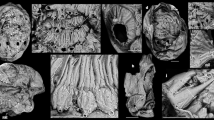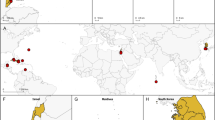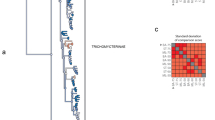Abstract
The position of Xenacoelomorpha in the tree of life remains a major unresolved question in the study of deep animal relationships1. Xenacoelomorpha, comprising Acoela, Nemertodermatida, and Xenoturbella, are bilaterally symmetrical marine worms that lack several features common to most other bilaterians, for example an anus, nephridia, and a circulatory system. Two conflicting hypotheses are under debate: Xenacoelomorpha is the sister group to all remaining Bilateria (= Nephrozoa, namely protostomes and deuterostomes)2,3 or is a clade inside Deuterostomia4. Thus, determining the phylogenetic position of this clade is pivotal for understanding the early evolution of bilaterian features, or as a case of drastic secondary loss of complexity. Here we show robust phylogenomic support for Xenacoelomorpha as the sister taxon of Nephrozoa. Our phylogenetic analyses, based on 11 novel xenacoelomorph transcriptomes and using different models of evolution under maximum likelihood and Bayesian inference analyses, strongly corroborate this result. Rigorous testing of 25 experimental data sets designed to exclude data partitions and taxa potentially prone to reconstruction biases indicates that long-branch attraction, saturation, and missing data do not influence these results. The sister group relationship between Nephrozoa and Xenacoelomorpha supported by our phylogenomic analyses implies that the last common ancestor of bilaterians was probably a benthic, ciliated acoelomate worm with a single opening into an epithelial gut, and that excretory organs, coelomic cavities, and nerve cords evolved after xenacoelomorphs separated from the stem lineage of Nephrozoa.
This is a preview of subscription content, access via your institution
Access options
Subscribe to this journal
Receive 51 print issues and online access
We are sorry, but there is no personal subscription option available for your country.
Buy this article
- Purchase on SpringerLink
- Instant access to full article PDF
Prices may be subject to local taxes which are calculated during checkout




Similar content being viewed by others
Accession codes
References
Dunn, C. W., Giribet, G., Edgecombe, G. D. & Hejnol, A. Animal phylogeny and its evolutionary implications. Annu. Rev. Ecol. Evol. Syst. 45, 371–395 (2014)
Hejnol, A. et al. Assessing the root of bilaterian animals with scalable phylogenomic methods. Proc. R. Soc. B 276, 4261–4270 (2009)
Srivastava, M., Mazza-Curll, K. L., van Wolfswinkel, J. C. & Reddien, P. W. Whole-body acoel regeneration is controlled by Wnt and Bmp-Admp signaling. Curr. Biol. 24, 1107–1113 (2014)
Philippe, H. et al. Acoelomorph flatworms are deuterostomes related to Xenoturbella . Nature 470, 255–258 (2011)
Nielsen, C. Animal Evolution: Interrelationships of the Living Phyla (Oxford Univ. Press, 2012)
Ehlers, U. Das phylogenetische System der Plathelminthes (G. Fischer, 1985)
Smith, J. P. S., III, Tyler, S. & Rieger, R. M. Is the Turbellaria polyphyletic? Hydrobiologia 132, 13–21 (1986)
Haszprunar, G. Plathelminthes and Plathelminthomorpha — paraphyletic taxa. J. Zool. Syst. Evol. Res. 34, 41–48 (1996)
Ruiz-Trillo, I., Riutort, M., Littlewood, D. T. J., Herniou, E. A. & Baguña, J. Acoel flatworms: earliest extant bilaterian metazoans, not members of Platyhelminthes. Science 283, 1919–1923 (1999)
Steinböck, O. Ergebnisse einer von E. Reisinger & O. Steinböck mit Hilfe des Rask-Örsted fonds durchgefuhrten Reise in Grönland 1926. 2. Nemertoderma bathycola nov. gen. nov. spec., eine eigenartige Turbellarie aus der Tiefe der Diskobay: nebst einem Beitrag zur Kenntnis des Nemertinenepithels. Vidensk. Medd. Dan. Naturhist. Foren. 90, 47–84 (1930)
Paps, J., Baguñà, J. & Riutort, M. Bilaterian phylogeny: a broad sampling of 13 nuclear genes provides a new Lophotrochozoa phylogeny and supports a paraphyletic basal acoelomorpha. Mol. Biol. Evol. 26, 2397–2406 (2009)
Jondelius, U., Ruiz-Trillo, I., Baguñà, J. & Riutort, M. The Nemertodermatida are basal bilaterians and not members of the Platyhelminthes. Zool. Scr. 31, 201–215 (2002)
Westblad, E. Xenoturbella bocki n.g, n.sp, a peculiar, primitive turbellarian type. Ark. Zool. 1, 3–29 (1949)
Franzén, Å. & Afzelius, B. A. The ciliated epidermis of Xenoturbella bocki (Platyhelminthes, Xenoturbellida) with some phylogenetic considerations. Zool. Scr. 16, 9–17 (1987)
Ehlers, U. & Sopott-Ehlers, B. Ultrastructure of the subepidermal musculature of Xenoturbella bocki, the adelphotaxon of the Bilateria. Zoomorphology 117, 71–79 (1997)
Norén, M. & Jondelius, U. Xenoturbella’s molluscan relatives…. Nature 390, 31–32 (1997)
Bourlat, S. J. et al. Deuterostome phylogeny reveals monophyletic chordates and the new phylum Xenoturbellida. Nature 444, 85–88 (2006)
Bourlat, S. J., Rota-Stabelli, O., Lanfear, R. & Telford, M. J. The mitochondrial genome structure of Xenoturbella bocki (phylum Xenoturbellida) is ancestral within the deuterostomes. BMC Evol. Biol. 9, 107 (2009)
Mwinyi, A. et al. The phylogenetic position of Acoela as revealed by the complete mitochondrial genome of Symsagittifera roscoffensis. BMC Evol. Biol. 10, 309 (2010)
Ruiz-Trillo, I., Riutort, M., Fourcade, H. M., Baguñà, J. & Boore, J. L. Mitochondrial genome data support the basal position of Acoelomorpha and the polyphyly of the Platyhelminthes. Mol. Phylogenet. Evol. 33, 321–332 (2004)
Rouse, G., Wilson, N. G., Carvajal, J. I. & Vrijenhoek, R. C. New deep-sea species of Xenoturbella and the position of Xenacoelomorpha. Nature http://dx.doi.org/10.1038/nature16545 (this issue)
Thomson, R. C., Plachetzki, D. C., Mahler, D. L. & Moore, B. R. A critical appraisal of the use of microRNA data in phylogenetics. Proc. Natl Acad. Sci. USA 111, E3659–E3668 (2014)
Jondelius, U., Wallberg, A., Hooge, M. & Raikova, O. I. How the worm got its pharynx: phylogeny, classification and Bayesian assessment of character evolution in Acoela. Syst. Biol. 60, 845–871 (2011)
Le, S. Q., Dang, C. C. & Gascuel, O. Modeling protein evolution with several amino acid replacement matrices depending on site rates. Mol. Biol. Evol. 29, 2921–2936 (2012)
Dunn, C. W. et al. Broad phylogenomic sampling improves resolution of the animal tree of life. Nature 452, 745–749 (2008)
Mirarab, S. et al. ASTRAL: genome-scale coalescent-based species tree estimation. Bioinformatics 30, i541–i548 (2014)
Bleidorn, C. et al. On the phylogenetic position of Myzostomida: can 77 genes get it wrong? BMC Evol. Biol. 9, 150 (2009)
Whelan, N. V., Kocot, K. M., Moroz, L. L. & Halanych, K. M. Error, signal, and the placement of Ctenophora sister to all other animals. Proc. Natl Acad. Sci. USA 112, 5773–5778 (2015)
Hejnol, A. & Martindale, M. Q. Acoel development supports a simple planula-like urbilaterian. Phil. Trans. R. Soc. B 363, 1493–1501 (2008)
Laumer, C. E. et al. Spiralian phylogeny informs the evolution of microscopic lineages. Curr. Biol. 25, 2000–2006 (2015)
Grabherr, M. G. et al. Full-length transcriptome assembly from RNA-Seq data without a reference genome. Nature Biotechnol. 29, 644–652 (2011)
Ebersberger, I., Strauss, S. & von Haeseler, A. HaMStR: profile hidden markov model based search for orthologs in ESTs. BMC Evol. Biol. 9, 157 (2009)
Lechner, M. et al. Proteinortho: detection of (co-)orthologs in large-scale analysis. BMC Bioinformatics 12, 124 (2011)
Kocot, K. M. et al. Phylogenomics reveals deep molluscan relationships. Nature 477, 452–456 (2011)
Cannon, J. T. et al. Phylogenomic resolution of the hemichordate and echinoderm clade. Curr. Biol. 24, 2827–2832 (2014)
Katoh, K., Kuma, K., Toh, H. & Miyata, T. MAFFT version 5: improvement in accuracy of multiple sequence alignment. Nucleic Acids Res. 33, 511–518 (2005)
Misof, B. & Misof, K. A Monte Carlo approach successfully identifies randomness in multiple sequence alignments: a more objective means of data exclusion. Syst. Biol. 58, 21–34 (2009)
Price, M. N., Dehal, P. S. & Arkin, A. P . FastTree 2—approximately maximum-likelihood trees for large alignments. PLoS One 5, e9490 (2010)
Kocot, K. M., Citarella, M. R., Moroz, L. L. & Halanych, K. M. PhyloTreePruner: a phylogenetic tree-based approach for selection of orthologous sequences for phylogenomics. Evol. Bioinform. Online 9, 429–435 (2013)
Rice, P., Longden, I. & Bleasby, A. EMBOSS: the European Molecular Biology Open Software Suite. Trends Genet. 16, 276–277 (2000)
Struck, T. H. TreSpEx-Detection of misleading signal in phylogenetic reconstructions based on tree information. Evol. Bioinform. Online 10, 51–67 (2014)
Criscuolo, A. & Gribaldo, S. BMGE (Block Mapping and Gathering with Entropy): a new software for selection of phylogenetic informative regions from multiple sequence alignments. BMC Evol. Biol. 10, 210 (2010)
Stamatakis, A. RAxML version 8: a tool for phylogenetic analysis and post-analysis of large phylogenies. Bioinformatics 30, 1312–1313 (2014)
Darriba, D., Taboada, G. L., Doallo, R. & Posada, D. ProtTest 3: fast selection of best-fit models of protein evolution. Bioinformatics 27, 1164–1165 (2011)
Lartillot, N., Rodrigue, N., Stubbs, D. & Richer, J. PhyloBayes MPI: phylogenetic reconstruction with infinite mixtures of profiles in a parallel environment. Syst. Biol. 62, 611–615 (2013)
Ronquist, F. et al. MrBayes 3.2: efficient Bayesian phylogenetic inference and model choice across a large model space. Syst. Biol. 61, 539–542 (2012)
Acknowledgements
The Swedish Research Council provided funding for U.J. and J.T.C. (grant 2012-3913) and F.R. (grant 2014-5901). A.H. received support from the Sars Core budget and Marie Curie Innovative Training Networks ‘NEPTUNE’ (FP7-PEOPLE-2012-ITN 317172) and FP7-PEOPLE-2009-RG 256450. We thank N. Lartillot and K. Kocot for discussions. Hejnol laboratory members K. Pang and A. Børve assisted with RNA extraction; A. Boddington, J. Bengtsen and A. Elde assisted with culture for Isodiametra pulchra and Convolutriloba macropyga. Thanks to W. Sterrer for collection of Sterreria sp. and Ascoparia sp., and to R. Janssen for finding X. bocki. The Sven Lovén Centre of Marine Sciences Kristineberg, University of Gothenburg, and the Interuniversity Institute of Marine Sciences in Eilat provided logistical support for field collection. S. Baldauf assisted with laboratory space and resources for complementary DNA synthesis. We thank K. Larsson for the original illustrations. Computations were performed on resources provided by the Swedish National Infrastructure for Computing (SNIC). Transcriptome assembly, data set construction, RAxML and PhyloBayes analyses were performed using resources provided through Uppsala Multidisciplinary Center for Advanced Computational Science (UPPMAX) under project b2013077, and MrBayes analyses were run under project snic2014-1-323.
Author information
Authors and Affiliations
Contributions
J.T.C., U.J., B.C.V., and A.H. conceived and designed the study. U.J. and A.H. collected several specimens and J.S. III collected Diopisthoporus gymnopharyngeus specimens. J.T.C. and B.C.V. performed molecular work and RNA sequencing assembly. J.T.C. assembled the datasets and performed phylogenetic analyses. F.R. conducted Bayesian phylogenetic analyses using MrBayes. All authors contributed to writing the manuscript.
Corresponding authors
Ethics declarations
Competing interests
The authors declare no competing financial interests.
Additional information
Sequence data have been deposited in the NCBI Sequence Read Archive under BioProject PRJNA295688. Data matrices and trees from this study are available from the Dryad Digital Repository (http://datadryad.org) under DOI 10.5061/dryad.493b7.
Extended data figures and tables
Extended Data Figure 1 Maximum likelihood topology of metazoan relationships inferred from 336 genes from the best-sampled 56 taxa.
Maximum likelihood tree is shown as inferred using the LG + I + Γ model for each gene partition, and 100 bootstrap replicates. Filled blue circles represent 100% bootstrap support. The length of the matrix is 81,451 amino acids and overall matrix completeness is 89%.
Extended Data Figure 2 Maximum likelihood topology of metazoan relationships inferred from 881 genes and 77 taxa.
Maximum likelihood tree is shown as inferred using the LG + I + Γ model for each gene partition, and 100 bootstrap replicates. Filled blue circles represent 100% bootstrap support. The length of the matrix is 337,954 amino acids and overall matrix completeness is 62%.
Extended Data Figure 3 Maximum likelihood topology of metazoan relationships inferred from 212 genes with Acoelomorpha removed.
Maximum likelihood tree is shown as inferred using the LG + I + Γ model for each gene partition, and 100 bootstrap replicates. Filled blue circles represent 100% bootstrap support. The length of the matrix is 43,942 amino acids and overall matrix completeness is 70%.
Extended Data Figure 4 ASTRAL species tree, constructed from 212 input partial gene trees inferred in RAxML version 8.0.20.
Nodal support values reflect the frequency of splits in trees constructed by ASTRAL from 100 bootstrap replicate gene trees.
Extended Data Figure 5 Bayesian inference topology of metazoan relationships inferred on the basis of 212 genes and 78 taxa.
Results are shown from MrBayes analyses of four independent Metropolis-coupled chains run for 4,000,000 generations, with sampling every 500 generations. Amino-acid data were back-translated to nucleotides and analysed under an independent substitution model.
Supplementary information
Supplementary Information
This file contains a Supplementary Discussion, Supplementary Tables 1-3 and Supplementary Figures 1-22. (PDF 5072 kb)
Rights and permissions
About this article
Cite this article
Cannon, J., Vellutini, B., Smith, J. et al. Xenacoelomorpha is the sister group to Nephrozoa. Nature 530, 89–93 (2016). https://doi.org/10.1038/nature16520
Received:
Accepted:
Published:
Issue Date:
DOI: https://doi.org/10.1038/nature16520
This article is cited by
-
Structure of putative epidermal sensory receptors in an acoel flatworm, Praesagittifera naikaiensis
Cell and Tissue Research (2024)
-
Highly conserved and extremely evolvable: BMP signalling in secondary axis patterning of Cnidaria and Bilateria
Development Genes and Evolution (2024)
-
Induced spawning with gamete release from body ruptures during reproduction of Xenoturbella bocki
Communications Biology (2023)
-
Acoel single-cell atlas reveals expression dynamics and heterogeneity of adult pluripotent stem cells
Nature Communications (2023)
-
Emergence of distinct syntenic density regimes is associated with early metazoan genomic transitions
BMC Genomics (2022)



